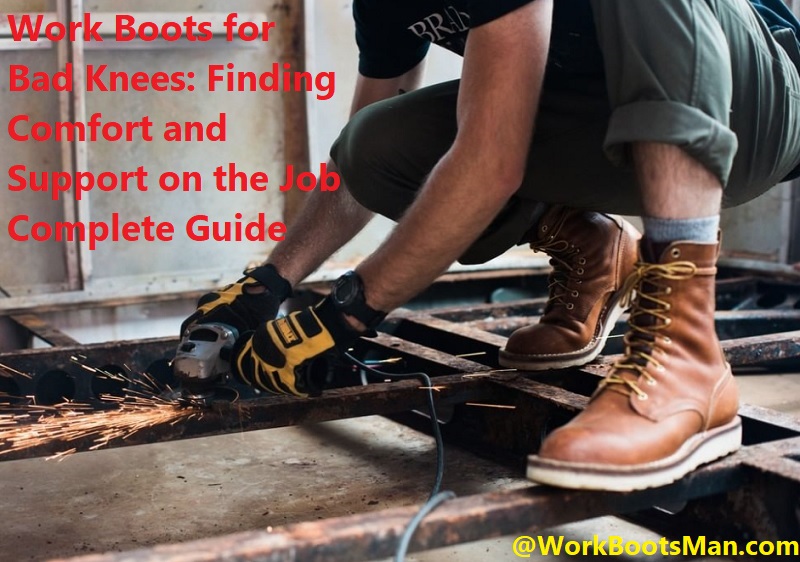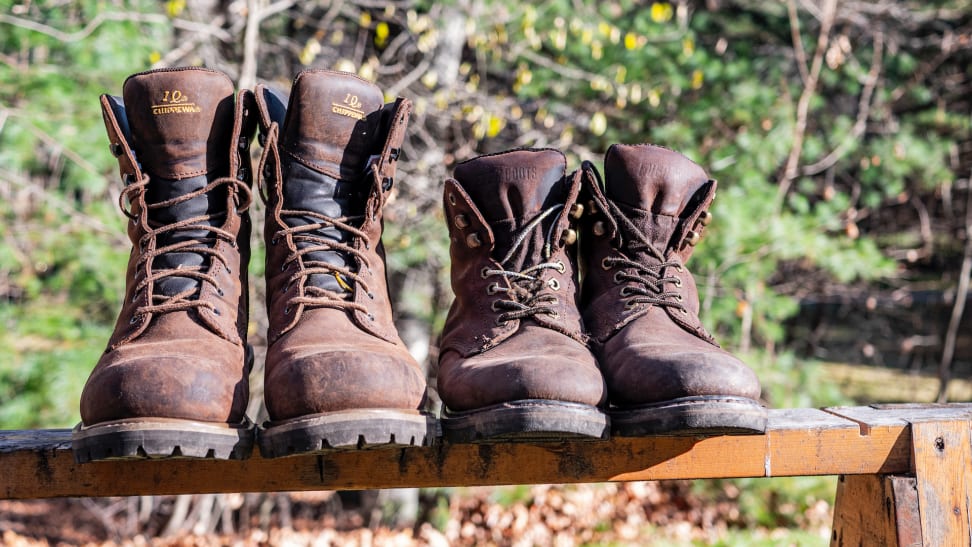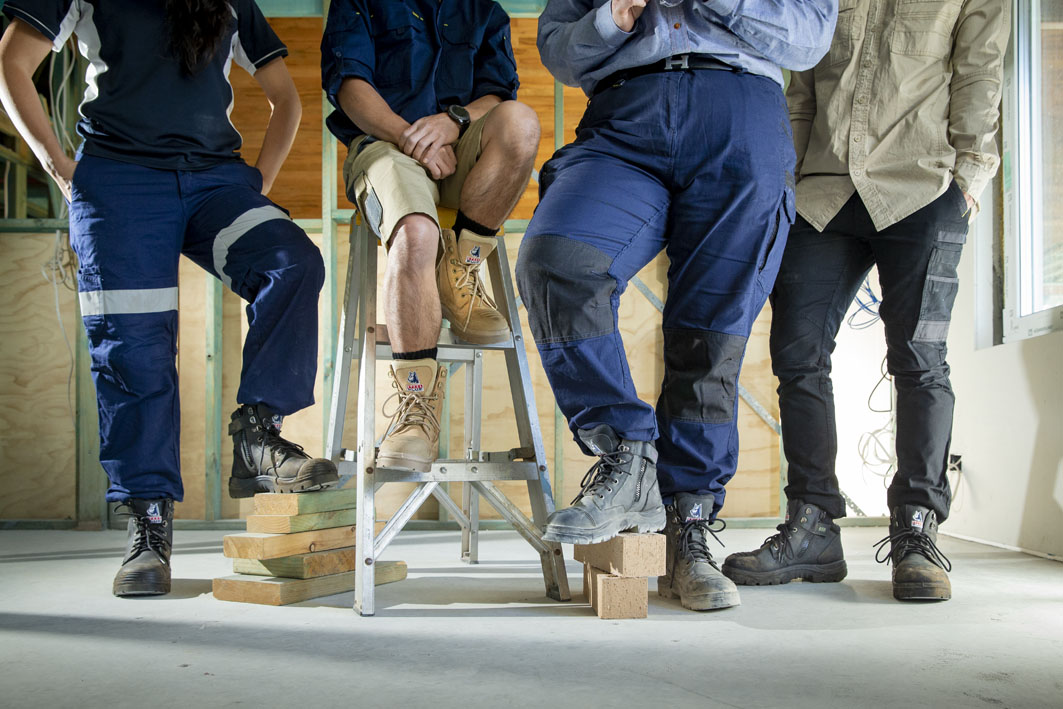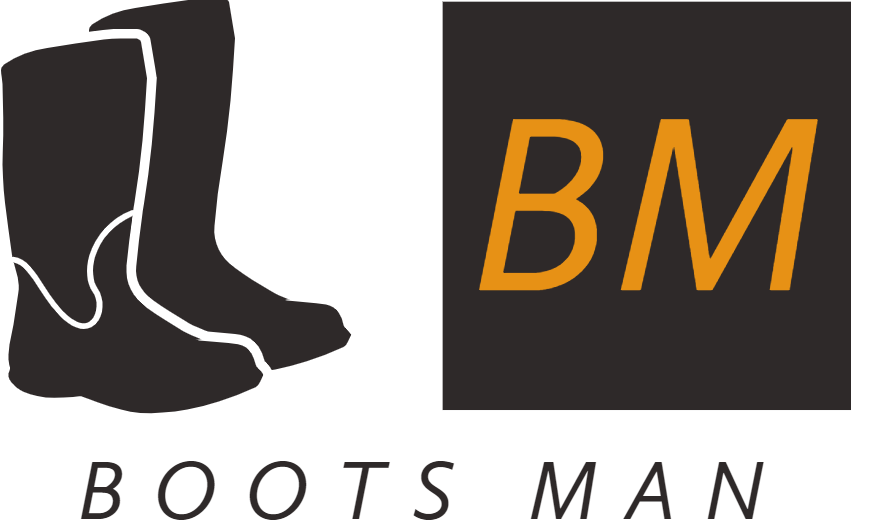Got bad knees but need the right work boots for your job? Don’t worry! You can comfortably work with bad knees and the right pair of work boots.
In this article, we’ll show you how to choose the best pair of work boots for your specific needs. Read on to learn more and find comfort and support on the job.
When you have bad knees, choosing the right work boots can seem like an overwhelming task. Not only do you need to find a pair that provide the appropriate level of comfort and support for your weakened joints, but you also need to select boots that aren’t too heavy or cumbersome, as those can make your condition much worse.
Fortunately, there is a wide range of available products on the market today that are specifically designed for people with bad knees. In this guide, we will review how to choose work boots that meet your needs while providing optimal safety and protection. We’ll discuss important considerations such as cushioning, arch support, and flexibility as well as factors like weight and construction materials. Finally, we’ll provide potential recommendations based on our research in order to get you started on your journey toward finding the perfect pair of comfortable and supportive work boots for bad knees.

Explanation of the importance of work boots for people with bad knees
For people with bad knees, finding the right work boots that provide comfort and support is a must. The wrong work boots can cause pain, joint stiffness, and fatigue. Not to mention, it can also worsen existing knee conditions. Therefore, it’s very important for people with bad knees to wear the right kind of work boots in order for them to function properly and be productive on the job.
Having the correct pair of work boots does not only make it easier to move around and stay comfortable during long shifts, but it also plays a role in reducing injury due to muscle strain or overexertion of joints. To meet these needs, it’s important for people with bad knees to strike the perfect balance between comfort, durability and support when selecting the right pair of work boots. Doing so will ensure that they receive adequate protection while doing any physical labor on their job site; thus eliminating any fears associated with injury due to improperly fitting shoes.
The objective of the guide
The purpose of this complete guide to finding work boots for bad knees is to provide comprehensive information about the best options in terms of comfort and support. We will explore different types of boots, their features, and selecting tips specifically tailored to individuals with an underlying knee condition that requires extra attention while working.
Furthermore, we will discuss general style tips that can help any individual comfortably navigate the workplace without sacrificing fashion-sense. For each type of boot, we’ll analyze how it can benefit those with thick calves or wide feet in ways that make it the most comfortable option possible for both durability and support. Along with this, we’ll offer other helpful ideas and strategies when choosing footwear like heel height, sole material, wicking liners, or a high top cut.
The aim is to provide readers with everything they need to know in order to make informed decisions on work boots so they can properly manage the effects that their knee condition has on their body throughout a workday.
Understanding Bad Knees
Having bad knees can mean dealing with a number of problems. Common symptoms of discomfort include joint pain, stiffness, swelling, and difficulty performing everyday activities such as walking or running. It can also lead to instability, reduced range of motion, and even muscle weakness if left untreated. Understanding the causes and symptoms of bad knees is key to finding the right boot for each person’s needs.
The most common causes of knee discomfort are overuse injuries or age-related wear and tear on the joints. These might include: arthritis, tendonitis, bursitis, or meniscus tears. Injury-related knee problems could stem from sporting activities, falls from heights or medical conditions like osteoarthritis. To get a proper diagnosis for underlying knee issues that may be causing pain during work shifts it is important to see a medical specialist as soon as possible.
Other factors such as obesity have been shown to increase the risk for this type of joint discomfort due to excess pressure placed on weight bearing joints like the legs and ankles. Additionally, an improper leg alignment such as overpronation (rolling in) can take its toll on any person’s lower extremities in time without proper care through footwear and orthopaedic devices such as arch supports or insoles. The key is properly supporting your feet while on duty so they don’t overwhelm your weak knees with too much strain while engaging in tasks requiring movement all throughout an average work day shift.
Common knee problems that require work boots
Knee problems can be caused by a variety of factors, many of which are related to age, overuse injuries, or even genetics. In order to find the right kind of work boots for bad knees, it is important to first understand what sort of knee problems you may be dealing with. Below are some of the most common conditions that make finding suitable work boots a challenge:
- Osteoarthritis: This is a degenerative condition in which the cushioning between joints becomes eroded over time due to joint use. The resulting pain can be especially severe around the knee joints if left untreated and without suitable support from properly fitted footwear from brands like Carhartt Timberland Pro or Wolverine.
- Meniscus Tears: The meniscus is a band-like structure in your human knee joint that helps provide stability and cushioning on both sides of the joint. When this tissue becomes torn it can cause significant discomfort and instability as you move about your workplace and perform tasks that involve walking or kneeling on hard surfaces. Look for footwear with extra cushioning technology made by brands like Carhartt WPX that offer extra layers of comfort and support where it’s needed most while working on tough job sites.
- Patellofemoral Pain Syndrome (PFPS): This syndrome involves pain arising from anatomical misalignment where your thighbone (femur) meets your kneecap (patella). Without proper footwear offering increased lateral stability, PFPS can become worse as muscles strain to compensate during activity forcing them to become increasingly tight and painful with repeated movement also known as “runners knee” Great work boot brands such as Ariat that offer features like their 4LR™ technology provides maximum lateral stability allowing for improved foot posture throughout the day long shifts on tough terrain without sacrificing comfort or support .
How bad knees affect work performance
Suffering from bad knees can have a significant impact on your ability to perform your job duties safely and efficiently. Pain and stiffness in the knee joint can make it difficult to stand for long periods of time, walk around the work site, climb ladders or steps, move heavy objects or even simply kneel down. Knee pain can also cause instability, which increases the risk for slips and falls leading to serious injury. A reduction in mobility due to bad knees can lead to both physical and psychological distress with the associated lost wages resulting in economic burdens.
To reduce the impact of bad knees on work performance, it is important to find work boots that provide adequate cushioning and support so you are able to be active on-the-job while remaining comfortable throughout the day. Features such as arch support, shock absorption materials in the soles, heel stabilizers and padded insoles are important considerations when purchasing a pair of work boots designed specifically for people with bad knees. Different styles were designed with comfort factors like breathability and flexibility enabling you to move freely without worry about irritation or pain from rubbing or chafing caused by ill-fitting footwear. Other features may include slip-resistant properties essential for wet and slippery surfaces common at many worksites.
The importance of proper footwear for knee health
When it comes to knee health, choosing the right pair of shoes is key. When you have bad knees, your feet absorb more shock with each stride and having good support is essential. For those who have knee pain due to arthritis, osteoarthritis or injury, finding the most supportive and comfortable work boot can help reduce pain and increase stability on the job. The first step in buying a new pair of boots is deciding on a style that offers the best protection for your needs. Here are some tips for making sure you get a pair of boots that will keep your knees healthy:
- Look for boots with padded collars and tongue to reduce friction and pressure on sensitive areas.
- Choose boots with insoles that provide cushioning and arch support. Many brands also offer removable insoles which are perfect for adjusting fit in order to accommodate different lengths or widths of feet.
- Check the sole material – built-up soles with tough tread should provide extra cushioning while still grip well when walking across slippery surfaces.
- Be aware that even if you find a work boot that fits properly, it may not be suitable for extended periods of standing, kneeling or sitting. Consider bringing along other footwear when needed in order to reduce fatigue or discomfort over time.
- Don’t forget about toe space! Make sure there’s room at the tip of your toes while wearing boots so they don’t become pinched when walking long distances.
Characteristics of Work Boots for Bad Knees
When selecting work boots for bad knees, there are many factors to consider. Some characteristics that are important to evaluate when selecting a boot are arch support, cushioning, shock absorption, and stability.
Arch Support: A properly fitted work boot should provide strong arch support which helps distribute the weight of the body evenly and reduce stress on your joints like the knee. Look for a boot that has an inflexible arch support or if your feet have a low arch consider looking for a shoe with a removable insert that you can customize to fit your own foot shape.
Cushioning: Work boots with cushioning will add comfort for those with tender knees by providing additional shock absorption. Cushioning in the heel will provide better stabilization and balance when walking on uneven surfaces which puts less strain on knee joints.
Shock Absorption: A good work boot should also include shock-absorbing insole sole materials such as rubber or gel which helps to reduce the pain caused by repetitive impacts while standing or walking on hard surfaces all day long.
Stability: Sturdy heels with good grip will help keep your feet firmly planted to the ground and decrease your risk of slips and falls that could lead to knee injuries or pain flares-up. Look as well for extra reinforcements along the sides of shoes provide extra lateral stability when standing on uneven ground or in slippery conditions.
Supportive features to look for in work boots
If you have bad knees, selecting the right pair of work boots is a crucial part of maintaining your comfort and safety on the job. A supportive boot can provide extra stability, prevent excessive strain on your joints, and even improve your posture. As you shop around for a pair of work boots, there are a few features that will help offer the best support possible.
Ankle Support: Ankle support is an important part of helping to stabilize and protect your knees. Look for boots with good ankle support features that are comfortable but still keep the foot secure and snug in place. A supportive tongue can also add extra protection against ankle rollover and prevent any strain on your joints.
Cushioned Footbed: Find a boot with cushioning in the footbed to soften each step with each stride and reduce shock from impact from walking or running over hard surfaces throughout the day.
Anti-Slip Grip: An anti-slip design offers extra traction against slippery surfaces, which can be helpful if you’re working in slippery conditions — reducing any chances for slips or falls that would further harm strained joints or ligaments even more.
Heel Counter: A heel counter helps to minimize slippage of shoes as it locks down snugly against your heels as opposed to allowing lace pressure to cause excess movement throughout the day – reducing any discomfort while providing crucial stability controls while in motion when you’re on the job.
Materials that provide maximum comfort and durability
When considering the materials of a work boot, many people prioritize durability over comfort because rough and repetitive movements or standing for long hours can cause wear and tear on the material of the shoe. However, while durability is important, finding a good balance between comfort and durability are key when looking for boots with bad knees.
Leather remains one of the most popular shoe materials, as it offers a high level of comfort and is incredibly durable. However, some leathers can be rigid or scratchy when used in work boots—a potential problem if you have arthritis or weak joints. For maximum comfort, look for thick leather that is oil-tanned to make it more water resistant while simultaneously making it softer to the touch.
Synthetic materials are known to be less porous than leathers, which makes them resistant to spills or stains common in working outside. Synthetics like nubuck have become increasingly popular due to their softness and quality resistance but these can be quite expensive higher-end options for work boots with weakened knees. Last but not least suede offers a great amount of flexibility but lacks water resistance making them less desirable for those dealing with bad knee pain during harsh weather conditions or rough jobsites since moisture can easily seep in and cause further irritation. When purchasing work boots with weakened knees always opt for those that leave plenty of room around your instep so the soft upper material can flex without causing strain on stressed joints around your ankle—especially when knelt down on hard ground surfaces.
How to choose the right size and fit
In order to ensure that you’re getting the best possible fit and the most comfortable possible support from your new work boots, it’s important to purchase the correct size. Many workers develop knee health problems due to ill-fitting footwear.
When selecting your work boots, measure your feet and try on several sizes inside the store. Consider personal preferences when choosing between different styles of boot fits, such as wider or roomier fits across the toe box and arch area or more snug fits with less room in areas like the heel cup.
Remember that taking the time to find a comfortable, supportive fit is a key part of preserving healthy knees at work.
Conclusion
To summarize, there is no one-size-fits-all boot solution for people who suffer from bad knees. While it may take some trial and error to find the right boot that offers enough support and cushioning, if done correctly you should be able to find a work boot that can significantly improve your comfort and safety on the job.
As long as you consider your options carefully and don’t settle for less than high-quality construction and craftsmanship, your choice of footwear should provide years of reliable use. It is important to remember that if done properly, finding the perfect work boots can make a huge difference in alleviating pain from bad knees and keep you going on the job without worrying about painful consequences later.
FAQs
What is the most comfortable work boots?
The most comfortable work boots will vary based on the individual’s preferences and needs. However, some popular brands known for their comfort include Timberland Pro, Red Wing, and Wolverine.
What shoes are best for knee pain when working out?
Shoes with good cushioning and support are best for knee pain when working out. Running shoes with a thicker sole and shock-absorbing features are recommended.
Are knee-high boots unprofessional?
It depends on the context and industry. Knee-high boots can be professional in some settings, such as the fashion industry, but may not be appropriate in more conservative work environments.
What should I wear for weak knees?
For weak knees, it’s important to wear supportive shoes with good cushioning and shock absorption. Knee braces or compression sleeves can also provide additional support.
How to choose knee boots?
When choosing knee boots, consider factors such as the purpose, material, heel height, and comfort level. It’s also important to ensure a proper fit, with enough room for the toes and a snug fit around the ankle and calf.
What are the benefits of knee boots?
Knee boots can provide additional support and warmth for the legs and ankles, and can also be a stylish accessory. They can protect the legs from rain, snow, and other elements.
Why do my knees hurt after wearing boots?
Knee pain after wearing boots could be caused by a lack of support or cushioning in the boots, or by an improper fit. It’s important to choose boots that provide adequate support and fit properly.
Can the wrong work boots cause knee pain?
Yes, the wrong work boots can cause knee pain. Poorly fitting or unsupportive boots can put stress on the knees, leading to pain and discomfort.
What boot brand is best for work?
There are several good boot brands for work, including Red Wing, Timberland Pro, Carhartt, and Wolverine. The best brand will depend on personal preference and the specific needs of the job.
How do I choose work boots?
When choosing work boots, consider factors such as safety features, comfort, durability, and the specific needs of the job. It’s also important to ensure a proper fit and to choose boots that meet any industry or safety standards.
See Also :
- Best work boots for overpronation 2023
- Best work boots for sweaty feet 2023
- Best wellington work boots 2023
- Best women’s boots for farm work 2023
- Best women’s pull on work boots 2023

